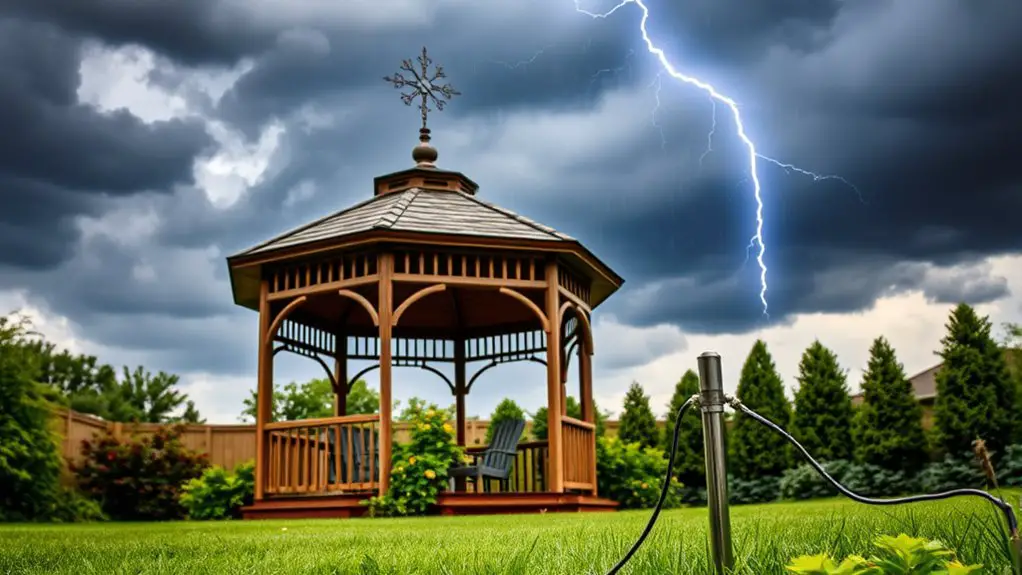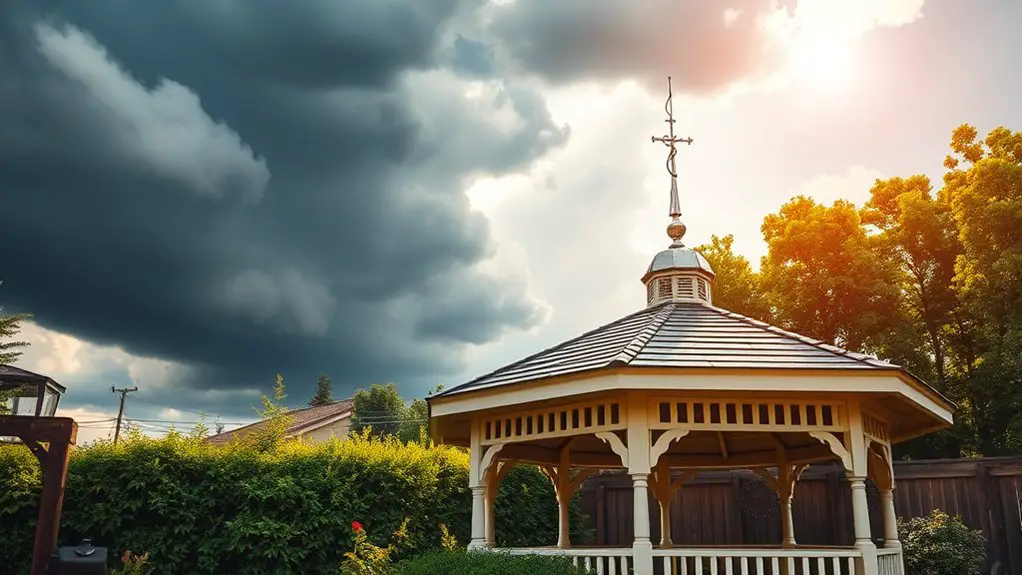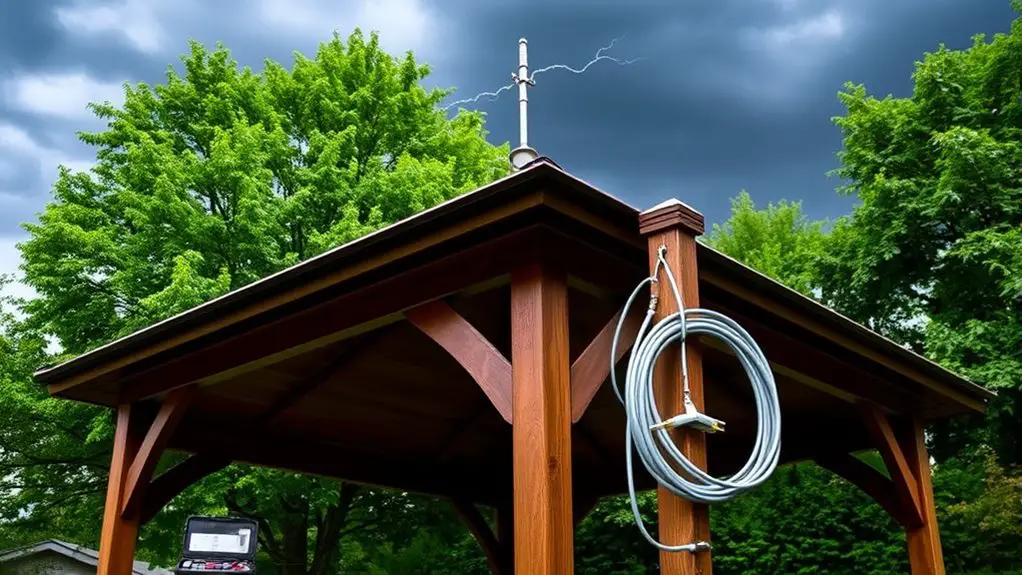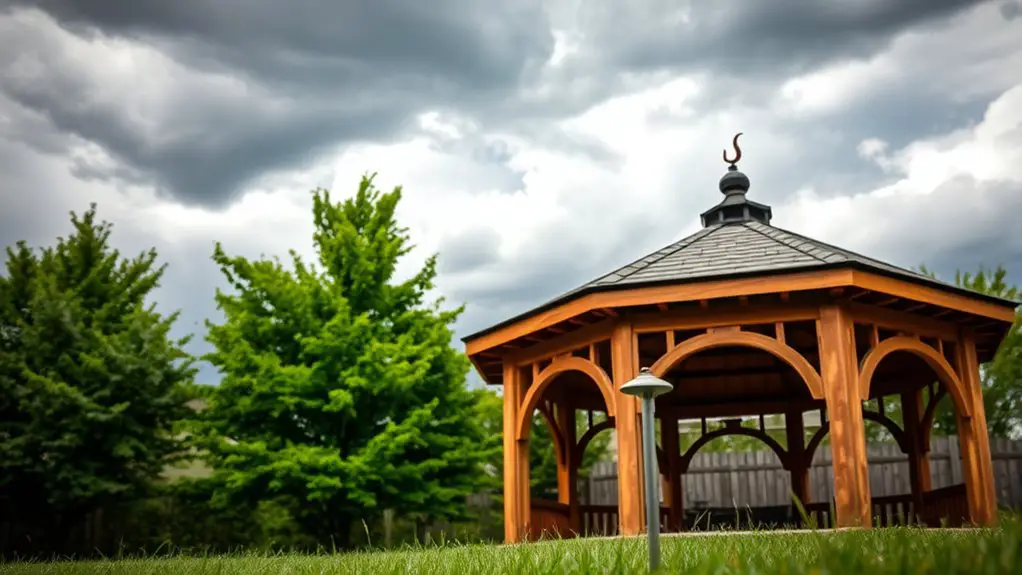To protect your gazebo from lightning strikes, start by selecting a safe location away from tall trees and water bodies while utilizing natural barriers for shielding. Install lightning rods at the highest point, bonding them to a copper grounding system for safety. Regular maintenance is key; inspect for damage and contemplate non-conductive materials for construction. Finally, establish a safe zone by clearing potential lightning attractors around your gazebo. There are more important steps to contemplate for complete protection.
Understanding the Risks of Lightning Strikes on Gazebos

When considering the safety of your gazebo, it’s important to understand the risks associated with lightning strikes, especially since they can cause significant damage or even pose a threat to life. Lightning behavior can be unpredictable, striking structures that are tall, conductive, or isolated. If your gazebo is crafted from metal or other conductive materials, it may serve as a pathway for electrical currents, leading to catastrophic outcomes.
The materials used in your gazebo play a vital role in its vulnerability. Wooden gazebos are less likely to conduct electricity than metal ones, but they can still ignite if struck. Understanding these risks allows you to make informed decisions about your gazebo’s design and location. By considering the behaviors of lightning and the materials involved, you can take proactive measures to minimize hazards, ensuring a safer environment for you and your loved ones while enjoying your outdoor space.
Choosing the Right Location for Your Gazebo
Selecting the right location for your gazebo is fundamental to reducing its risk of being struck by lightning. Consider the following factors when determining the best spot:
Choosing the right location for your gazebo is essential to minimize lightning strike risks.
- Gazebo Orientation: Position your gazebo so that it faces away from prevailing winds and storms, minimizing exposure.
- Landscape Features: Use natural barriers like trees or hills to shield your gazebo, but avoid placing it directly under tall trees, which can attract lightning.
- Elevation: Choose a site that’s not the highest point in your yard. Lower ground reduces the likelihood of being the first target for a lightning strike.
- Proximity to Water: Stay away from water bodies, as they can increase the risk of lightning strikes and may create hazardous conditions during storms.
Installing Lightning Rods for Protection

While you may take precautions in choosing the right location for your gazebo, installing lightning rods is an essential step in safeguarding it against potential lightning strikes. Different lightning rod types, such as air terminals and ground rods, serve distinct purposes. Air terminals attract lightning, directing it safely down to the ground, while ground rods dissipate the electrical charge into the earth.
When considering installation techniques, make sure the rod is positioned at the highest point of your gazebo for maximum effectiveness. Use non-corrosive materials to enhance durability and resistance against the elements. Securely bond the rod to a grounding system, which helps prevent electrical surges from damaging your structure.
Additionally, pay attention to local regulations and standards for lightning protection systems. By investing in proper lightning rod installation, you can considerably reduce the risk of lightning damage and protect your outdoor haven while enjoying the freedom of your space.
Utilizing Grounding Systems Effectively
Although many people overlook the importance of grounding systems, they play an essential role in protecting your gazebo from lightning strikes. Effective grounding techniques can greatly enhance your electrical safety and reduce the risk of damage. Here are some key strategies to take into account:
- Install a Grounding Rod: Place a copper grounding rod at least eight feet deep into the earth to create a reliable connection.
- Use Conductive Materials: Verify that the wiring and rods are made of high-quality conductive materials to maximize effectiveness.
- Bonding: Connect all metal components of your gazebo to the grounding system to prevent any voltage differentials during a strike.
- Regular Testing: Periodically test the grounding system to verify it remains effective and compliant with safety standards.
Regular Maintenance and Inspections

To guarantee your gazebo remains safe from lightning strikes, regular maintenance and inspections are vital. You’ll want to inspect the structural integrity periodically, looking for any signs of wear or damage. Additionally, maintaining the grounding systems is essential for effective protection against electrical surges.
Inspect Structural Integrity
Regular maintenance and inspections are essential for guaranteeing the structural integrity of your gazebo, particularly when it comes to safeguarding it against lightning strikes. Performing regular structural assessments helps identify potential weaknesses, guaranteeing material durability over time. Here are key aspects to inspect:
- Wood Condition: Check for rot or insect damage that could compromise strength.
- Metal Components: Look for rust or corrosion, which can weaken connections.
- Fasteners: Guarantee screws and bolts are tight and free from wear.
- Foundation Stability: Inspect the base for shifting or erosion that can affect overall stability.
Maintain Grounding Systems
After confirming the structural integrity of your gazebo, it’s important to focus on the grounding systems that play an essential role in lightning protection. Regular maintenance and inspections of your grounding techniques are important. Check the grounding materials, like copper rods and conductive cables, for corrosion or damage. Any deterioration can greatly compromise their effectiveness. Also, verify that connections are secure and that the grounding system is properly bonded to the gazebo structure. Schedule inspections at least annually or after severe weather events to assure peak performance. By taking these proactive steps, you enhance the safety of your gazebo, allowing you to enjoy your outdoor space with greater peace of mind, knowing you’re safeguarding it against lightning strikes.
Incorporating Non-Conductive Materials
To enhance your gazebo’s protection against lightning, consider using composite materials that offer non-conductive properties. Additionally, installing non-metal components can greatly reduce the risk of lightning strikes. These strategies create a safer environment by minimizing conductive pathways.
Use Composite Materials
Incorporating composite materials into your gazebo’s design can greatly enhance its protection against lightning strikes. These materials are not only non-conductive but also offer superior weather resistance, making them ideal for outdoor structures. By choosing the right composites, you can markedly reduce the risk of lightning damage while ensuring your gazebo remains durable and functional.
Consider these benefits of using composite materials:
- Non-conductive properties that minimize lightning attraction
- Lightweight nature for easy installation and mobility
- Resistance to rotting and corrosion, extending the gazebo’s lifespan
- Aesthetic versatility, allowing for various designs and finishes
Install Non-Metal Components
Choosing non-metal components for your gazebo can greatly enhance its resistance to lightning strikes. By utilizing non-metal materials like fiberglass, plastic, or treated wood, you effectively minimize the risk of lightning conduction. These materials are inherently non-conductive, providing a safer environment during storms. Additionally, consider applying protective coatings to further shield these components. Products like weather-resistant sealants and paints can not only extend the life of your gazebo but also add another layer of protection against electrical surges. When assembling your gazebo, prioritize these non-metal elements to guarantee you’re fostering a space that’s both aesthetically pleasing and safe from the unpredictable forces of nature. Embracing these choices empowers you to enjoy your gazebo without fear.
Creating a Safe Zone Around the Gazebo
While you may think your gazebo is a serene escape, creating a safe zone around it is essential for minimizing the risk of lightning strikes. Establishing a clear zone involves maintaining a safe distance from conductive materials and ensuring there are no tall objects nearby that could attract lightning. Here are some key considerations for your safe zone:
- Remove tall trees: Trim or eliminate trees that are taller than the gazebo.
- Avoid metal objects: Keep metal furniture or decorations away from the immediate area.
- Clear debris: Regularly remove leaves, branches, and other debris that could create hazards.
- Establish a radius: Aim for at least a 10-15 foot radius free of potential lightning attractors.
Educating Family and Guests on Safety Measures
Educating your family and guests about safety measures during thunderstorms is essential to ensuring their well-being while using the gazebo. Start by implementing safety training sessions that focus on recognizing storm signs and understanding the risks associated with being outdoors in such weather. Discuss the importance of seeking shelter inside a sturdy building rather than relying on the gazebo.
It’s also vital to establish clear emergency preparedness plans. Make sure everyone knows where to go and what to do if a storm approaches. Create a communication system, like a group chat, to alert each other of impending weather changes. Encourage everyone to keep their phones charged and have emergency contacts ready.
Frequently Asked Questions
Can a Gazebo Be Struck by Lightning if It’s Not Tall?
Yes, a gazebo can be struck by lightning, regardless of its height. Lightning safety measures should be considered during gazebo design, ensuring it’s adequately grounded and placed away from taller structures to minimize risk.
Are There Specific Materials That Attract Lightning More Than Others?
Certain lightning materials, like metal and conductive materials, can attract lightning due to their electrical conductivity. Choosing non-conductive materials for structures can help reduce the risk of lightning strikes affecting them during storms.
How Often Should I Test My Lightning Protection System?
Think of your lightning protection system like a car; regular maintenance is essential. Test it at least annually to guarantee functionality. Consistent lightning system maintenance prevents potential failures, keeping you and your outdoor space safe.
Can Planting Trees Nearby Help Reduce Lightning Strikes?
Planting trees nearby can reduce lightning risk by acting as natural conductors. However, tree placement is essential; trees should be strategically positioned away from structures to minimize potential damage, ensuring they don’t become lightning targets themselves.
What Should I Do Immediately After a Lightning Strike?
When thunder’s wrath cracks the sky, your immediate response matters. Check for injuries, call emergency services, and guarantee safety measures are in place. Your swift actions can protect lives and restore calm after nature’s fury.

